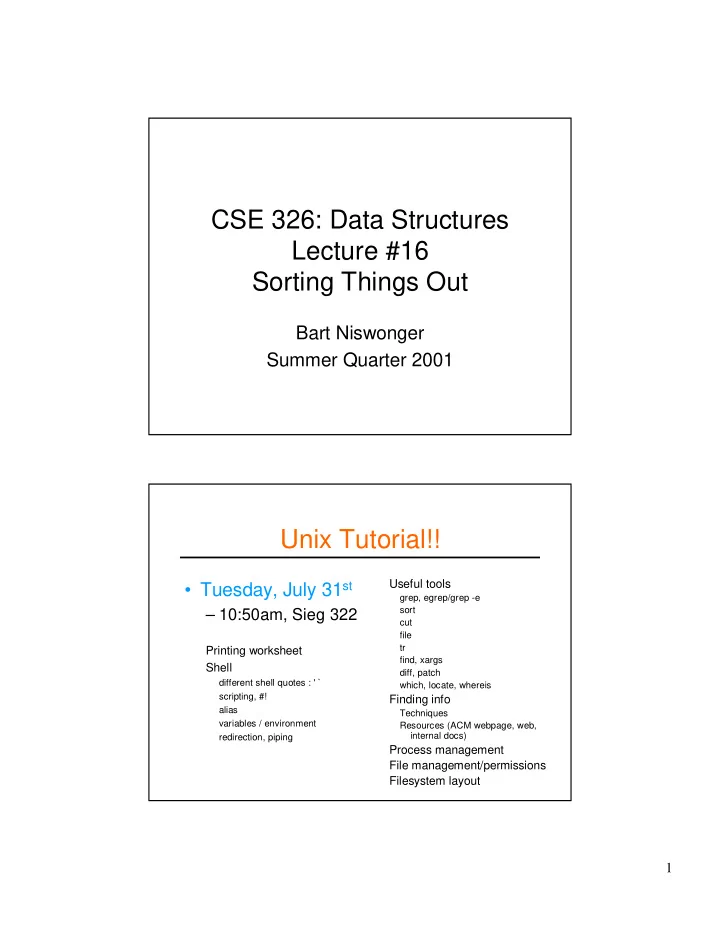

CSE�326:�Data�Structures Lecture�#16 Sorting�Things�Out Bart Niswonger Summer�Quarter�2001 Unix�Tutorial!! Useful�tools • Tuesday,�July�31 st grep, egrep/grep -e sort – 10:50am,�Sieg�322 cut file tr Printing�worksheet find, xargs Shell� diff,�patch different�shell�quotes�:�'�` which,�locate, whereis scripting,�#! Finding�info alias Techniques variables�/�environment Resources�(ACM webpage,�web,� internal�docs) redirection,�piping Process�management File�management/permissions Filesystem layout 1
Today’s�Outline • Project� – Rules�of�competition • Sorting�by�comparison – Simple�:� • SelectionSort;� BubbleSort; InsertionSort – Quick�: • QuickSort – Good�Worst�Case�: • MergeSort; HeapSort Sorting:�The�Problem�Space General�problem Given�a�set�of�N� orderable items,�put�them� in order Without�(significant)�loss�of�generality,�assume: – Items�are�integers – Ordering�is� � Most�sorting�problems�map�to�the�above�in�linear�time. 2
Selection�Sort 1. Find�the�smallest�element,�put�it�first 2. Find�the�next�smallest�element,�put�it� second 3. Find�the�next�smallest,�put�it�next … etc. Selection�Sort procedure SelectionSort�(Array[1..N] For i=1� to N-1 Find�the�smallest�entry�in�Array[i..N] Let�j be�the�index�of�that�entry Swap(Array[i],Array[j]) End�For While other�people�are�coding�QuickSort/MergeSort Twiddle�thumbs End While 3
HeapSort • Use�a�Priority�Queue�(Heap) 87 23 44 756 18 13 801 27 35 8 13 18 23 27 Shove�everything�into�a�queue,�take�them�out smallest�to�largest. QuickSort � � � � � � � � 28 � � � � � � � � � � � � � � � � 47 15 1. Basic�idea:�Pick�a� pivot. 2. Partition into�less-than�&�greater-than�pivot. 3. Sort�each�side� recursively . 4
QuickSort�Partition Pick�pivot 7 2 8 3 5 9 6 Partition�with� 7 2 8 3 5 9 6 cursors < > 2�goes�to 7 2 8 3 5 9 6 less-than < > 6,�8�swap 7 2 6 3 5 9 8 less/greater-than < > 3,5�less-than 7 2 6 3 5 9 8 9�greater-than Partition�done. 7 2 6 3 5 9 8 Recursively sort�each�side. Analyzing�QuickSort • Picking�pivot:�constant�time • Partitioning:�linear�time • Recursion:�time�for�sorting�left�partition� (say�of�size� i )�+�time�for�right�(size�N- i -1) T(1)�=�b T(N)��=��T( i )��+��T(N- i -1)��+�cN where� i is�the�number�of�elements�smaller than�the�pivot 5
QuickSort :�Worst�Case • What�is�the�worst�case? Optimizing�QuickSort • Choosing�the�Pivot – Randomly�choose�pivot • Good�theoretically�and�practically,�but�call�to�random�number� generator�can�be�expensive – Pick�pivot�cleverly • “Median-of-3”�rule�takes�element�at�Median(first�value,�last� value).��Works�well�in�practice. • Cutoff – Use�simpler�sorting�technique�below�a�certain�problem� size • Weiss suggests�using�insertion�sort,�with�a�cutoff�limit�of�5-20 6
QuickSort�:�Best�Case T(N)�=�T(i)�+�T(N-i-1)�+�cN T(N) =�2T(N/2�- 1)�+�cN <�2T(N/2)�+�cN <�4T(N/4)�+�c(2(N�/�2)�+�N) <�8T(N/8)�+�cN(1�+�1�+�1) <�kT(N/k)�+�cN�log�k�=�O(N�log�N) QuickSort�:�Average�Case • Assume�all�size�partitions�equally�likely,� with�probability�1/N � � � � � T N ( ) T i ( ) T N ( i 1) cN � � N 1 average�value�of�T(i)�or�T(N-i-1)� is��(1/ N ) T ( j ) � j 0 � � � � N 1 � � T N ( ) (2 / N ) T j ( ) cN � j 0 � ( log ) O N N details:�Weiss�pg�278-279 7
MergeSort MergeSort (Collection�[1..n]) 1. Split�Collection�in�half 2. Recursively�sort�each�half 3. merge two� sorted halves�together merge (C1[1..n],�C2[1..n]) i1=1,�i2=1 Merging�Cars�by�key while i1<n and�i2<n [Aggressiveness�of�driver]. if C1[i1]�<�C2[i2] Most�aggressive�goes�first. Next�is�C1[i1] i1++ else Next�is�C2[i2] i2++ end�If end�while MergeSort Analysis • Running�Time – Worst�case? – Best�case? – Average�case? • Other�considerations�besides�running� time? 8
✕ ✕ ✕ � ✕ ✄ ✕ ✄ ✕ � ✕ ✕ ✕ Is�This�The�Best�We�Can�Do? • Sorting�by�Comparison – Only�information�available�to�us�is�the� set� of�N�items to�be�sorted – Only�operation�available�to�us�is� pairwise� comparison�between�2�items What�is�the�best�running�time�we�can�possibly� achieve? Decision�Tree�Analysis �✂✁☎✄ ✄✒✁✓� �✔✁☎✄ ✄✒✁✓� �✗✄ ✄✖� ✁☎✄ ✁✓� Internal�node,�with ✆✞✝✠✟✠✡☞☛ facts�known�so�far Leaf�node,�with �✗✄ �✘✄ ✄✖� ordering�of�A,B,C ✌✎✍✑✏ Edge,�with�result of�one�comparison 9
How�deep�is�Decision�Tree? • How�many�permutations�are�there�of�N� numbers? • How�many�leaves�does�the�tree�have? • What’s�the�shallowest�tree�with�a�given� number�of�leaves? • What�is�therefore�the�worst�running�time� (number�of�comparisons)�by�the�best�possible� sorting�algorithm? Lower�Bound�for�log(n!) n � � n � � � � n ! 2 n Stirling’s approximation: � � e � � n � � n � � � � � � log( !) n log 2 n e � � � � � � � � n � � n � � � � � � � log( 2 n ) lo g � � ( log ) n n � � � � e � � 10
Is�This�The�Best�We�Can�Do? • Sorting�by�Comparison – Only�information�available�to�us�is�the� set� of�N�items to�be�sorted – Only�operation�available�to�us�is� pairwise� comparison�between�2�items What�happens�if�we�relax�these�constraints? BinSort (a.k.a.�BucketSort) Requires: – Knowing�the�keys�to�be�in�{1,�…,�K} – Having�an�array�of�size�K Works�by: Putting�items�into�correct�bin�(cell)�of�array,� based�on�key 11
BinSort�example K=5��list=(5,1,3,4,3,2,1,1,5,4,5) Bins�in�array key�=�1 1,1,1 key�=�2 2 Sorted�list: key�=�3 3,3 1,1,1,2,3,3,4,4,5,5,5 key�=�4 4,4 key�=�5 5,5,5 BinSort�Pseudocode procedure BinSort (List�L,K) LinkedList bins[1..K] //�Each�element�of�array�bins is�linked�list. //�Could�also�BinSort with�array�of�arrays. For�Each number�x in�L bins[x].Append(x) End�For For i =�1..K For�Each number�x in�bins[i] Print�x End�For End�For 12
BinSort Running�Time • K�is�a�constant – BinSort is�linear�time • K�is�variable – Not�simply�linear�time • K�is�large�(e.g.�2 32 ) – Impractical� BinSort�is�“stable” Definition: Stable�Sorting�Algorithm Items�in�input�with�the�same�key�end�up�in� the�same�order�as�when�they�began. • BinSort�is�stable – Important�if�keys�have�associated�values – Critical�for�RadixSort 13
Recommend
More recommend